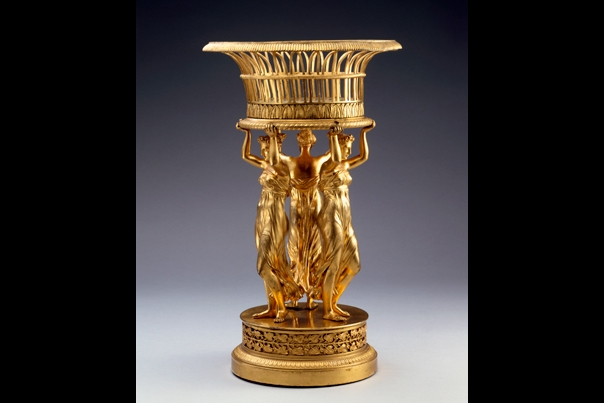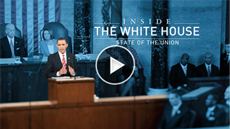Décor & Art: Rooms
The Art & Décor of the
Public Tour by Room
State Floor
Entrance Hall
Cross Hall
East Room
Green Room
The Blue Room
Red Room
State Dining Room
Ground Floor
Ground Floor Corridor
Library
Vermeil Room
China Room
East Garden Room
-
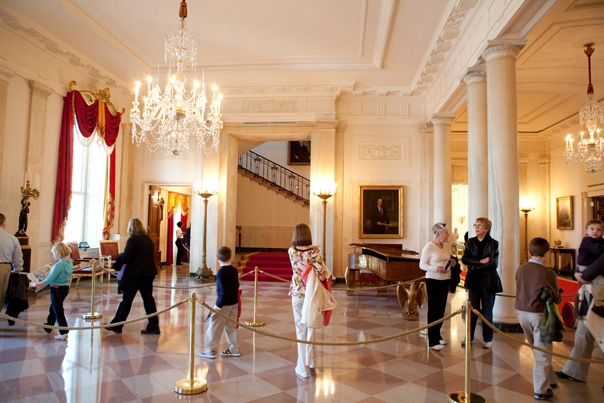
The public in the Grand Foyer of the WH, March 31, 2009. (Official WH Photo by S Appleton)
1 of 6 -

Painting of George Herbert Walker Bush by Herbert Elmer Abrams, 1994
2 of 6 -

Mantel Clock by Thomire & Co., c. 1817
3 of 6 -
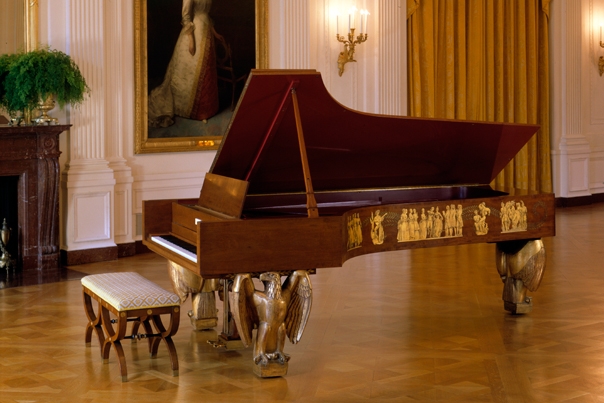
Piano by Steinway & Sons, 1938
4 of 6 -

Pier Table by Pierre-Antoine Bellangè, c. 1817
5 of 6 -

Painting of William Jefferson Clinton by Simmie Knox, 2001
6 of 6
Entrance Hall
Overlooking Pennsylvania Avenue, this hall serves as a grand foyer for the official reception rooms on the State Floor. During events, the United States Marine Band often performs in this location. Under President Thomas Jefferson, artifacts acquired by explorers Meriwether Lewis and William Clark (1803-6) and Zebulon Pike (1805-7) were displayed in the Entrance Hall.
The grand staircase leads from the State Floor to the Second Floor and is used primarily for ceremonial occasions. On the lowest landing, President Ronald Reagan took his second oath of office on January 20, 1985. Since inauguration day fell on a Sunday, a private ceremony was held in the White House that day with the official ceremony at the U.S. Capitol on the Monday following. Until 1902 two large staircases led from the State Floor to the Second Floor. A staircase at the west end of the Cross Hall that led to the Family Quarters was removed in 1902 to enlarge the State Dining Room. The winding staircase to the east of the Entrance Hall led to the rooms on the east end of the Second Floor that were used as the presidential offices before the creation of the West Wing. When the 1902 Grand Staircase was rebuilt during the Truman renovation, it was redirected to open into the Entrance Hall for more dramatic formal descents from the Second Floor.
-

The public in the Grand Foyer of the WH, March 31, 2009. (Official WH Photo by S Appleton)
1 of 6 -

Painting of George Herbert Walker Bush by Herbert Elmer Abrams, 1994
2 of 6 -

Mantel Clock by Thomire & Co., c. 1817
3 of 6 -

Piano by Steinway & Sons, 1938
4 of 6 -

Pier Table by Pierre-Antoine Bellangè, c. 1817
5 of 6 -

Painting of William Jefferson Clinton by Simmie Knox, 2001
6 of 6
Entrance Hall
Overlooking Pennsylvania Avenue, this hall serves as a grand foyer for the official reception rooms on the State Floor. During events, the United States Marine Band often performs in this location. Under President Thomas Jefferson, artifacts acquired by explorers Meriwether Lewis and William Clark (1803-6) and Zebulon Pike (1805-7) were displayed in the Entrance Hall.
The grand staircase leads from the State Floor to the Second Floor and is used primarily for ceremonial occasions. On the lowest landing, President Ronald Reagan took his second oath of office on January 20, 1985. Since inauguration day fell on a Sunday, a private ceremony was held in the White House that day with the official ceremony at the U.S. Capitol on the Monday following. Until 1902 two large staircases led from the State Floor to the Second Floor. A staircase at the west end of the Cross Hall that led to the Family Quarters was removed in 1902 to enlarge the State Dining Room. The winding staircase to the east of the Entrance Hall led to the rooms on the east end of the Second Floor that were used as the presidential offices before the creation of the West Wing. When the 1902 Grand Staircase was rebuilt during the Truman renovation, it was redirected to open into the Entrance Hall for more dramatic formal descents from the Second Floor.
-

President Obama walks down the Cross Hall of the White House, March 24, 2009. (Official White House Photo by Chuck Kennedy)
1 of 9 -

Chandelier attributed to William Parker, c. 1774
2 of 9 -

George Washington sculpture, artist unknown, c. 1790
3 of 9 -

Painting of Gerald Rudolph Ford by Everett Raymond Kinstler, 1977
4 of 9 -

Painting of Jimmy Carter by Herbert Elmer Abrams, 1982
5 of 9 -

Painting of John Fitzgerald Kennedy by Aaron Shikler, 1970
6 of 9 -
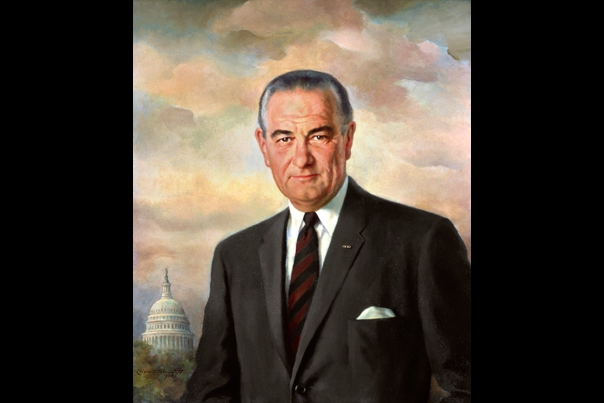
Painting of Lyndon Baines Johnson by Elizabeth Shoumatoff, 1968
7 of 9 -
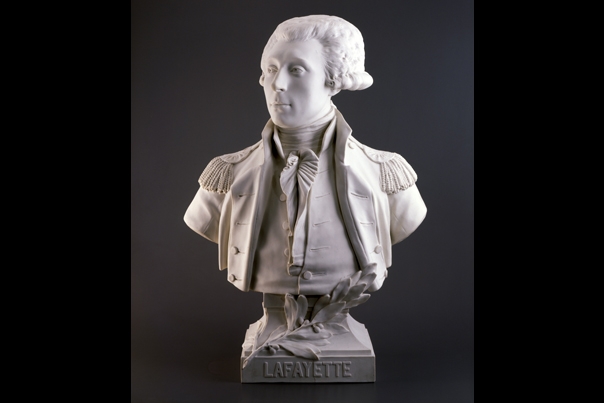
Marie Joseph Paul Yves Roch Gilbert du Motier, Marquis de Lafayette by National Porcelain Manufactory of Sèvres, 1904
8 of 9 -

Ronald Wilson Reagan by Everett Raymond Kinstler, 1991
9 of 9
Cross Hall
Behind the Entrance Hall is this central corridor that extends between the East Room and the State Dining Room. In 1837, to conserve heat in the state rooms, a glass screen was installed between the columns. In 1882, it was replaced by a screen of stained glass made by Louis C. Tiffany. Removed in 1902 and sold at auction, the Tiffany screen is believed to have been destroyed in a fire in 1923.
-
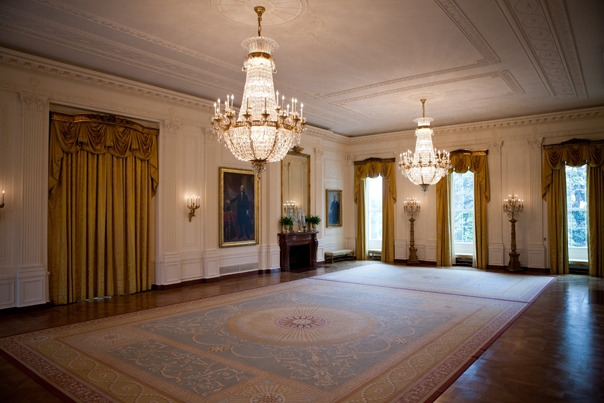
The East Room of the White House, May 17, 2010. (Official WH Photo by Chuck Kennedy)
1 of 8 -

Bench by L. Marcotte & Co. c. 1902-1903
2 of 8 -

Candelabrum by Pierre-Philippe Thomire c. 1817
3 of 8 -

Portrait of George Washington by Gilbert Stuart c. 1797.
4 of 8 -

Light Standard by Edward F. Caldwell & Co. c. 1902.
5 of 8 -

Martha Dandridge Custis Washington by Eliphalet Frazer Andrews c. 1878.
6 of 8 -

Theodore Roosevelt by John Singer Sargent c. 1903.
7 of 8 -

William McKinley by Harriet Anderson Stubbs Murphy c. 1902.
8 of 8
East Room
The largest room in the house, the East Room was designated by architect James Hoban as the "Public Audience Room.” It normally contains little furniture and traditionally is used for large gatherings, such as press conferences, bill-signing ceremonies, after-dinner entertaining, concerts, weddings, funerals, and award presentations. Five presidential daughters have been married in the room, most recently Lynda Johnson in 1967.
During her four-month occupancy of the President’s House in the winter of 1800-1801, Abigail Adams had her laundry hung out to dry in the unfinished East Room. President Thomas Jefferson partitioned the south end as a bedroom and office for his secretary, Meriwether Lewis, later co-leader of the Lewis and Clark expedition. James Madison later met with his cabinet in these southern rooms. The East Room was completed architecturally during the White House’s restoration following its burning in 1814, but the room was not fully furnished until 1829, during Andrew Jackson’s administration.
The East Room was the site of frequent activity during the Civil War. Union troops were quartered here for a period. In 1864, President Abraham Lincoln held a large reception here in honor of General Ulysses S. Grant shortly before his appointment as head of all the Union forces. Following his assassination in 1865, Lincoln lay in state in the East Room, as have all of the presidents who died in office with the exception of President James A. Garfield, as the East Room was being renovated at the time of his assassination.
In recent history, the East Room has served as the site of many important events including the signing of the Civil Rights Act in 1964 by President Lyndon Johnson, Gerald Ford’s swearing in as President in 1974, and the signing of the Camp David Accords in 1978. On March 23, 2010, President Barack Obama signed the Patient Protection and Affordable Care Act in this historic room.
Green Room
Throughout much of its existence, the Green Room has served as a parlor for teas and receptions. Here, Frances Cleveland held her first White House reception, and Edith Roosevelt received guests before the Friday musicales and concerts held in the adjoining East Room.
Under Thomas Jefferson, it was a dining room with a green canvas floor cloth. By 1825, under John Quincy Adams, the room had become the “Green Drawing Room,” named for the color of the draperies and upholsteries.
In 1862, Willie Lincoln died in the White House of typhoid fever, and his grieving parents placed his open casket in the Green Room. An account of the time stated that Mrs. Lincoln never again entered the room.
-

The Green Room of the White House, Feb. 18, 2009. (Official WH Photo by Joyce Boghosian)
1 of 21 -

Painting of Andrew Jackson by Ralph Eleaser Whiteside Earl, c. 1835
2 of 21 -

Painting of Benjamin Franklin by David Martin, 1767
3 of 21 -

Benjamin Franklin, sculpture by National Porcelain Manufactory of Sèvres, c. 1810
4 of 21 -

Painting of Benjamin Harrison by Jonathan Eastman Johnson, 1895
5 of 21 -

Farmyard in Winter by George Henry Durrie, 1858
6 of 21 -

Independence Hall in Philadelphia by Joachim Ferdinand Richardt (Reichardt), c. 1858
7 of 21 -

Painting of James Knox Polk by George Peter Alexander Healy, 1858
8 of 21 -

Painting of John Quincy Adams by George Peter Alexander Healy, 1858
9 of 21 -

Lighter Relieving a Steamboat Aground by George Caleb Bingham, 1847
10 of 21 -

Painting of Louisa Catherine Johnson Adams (Mrs. John Quincy Adams) by Gilbert Stuart, 1821
11 of 21 -

Mantel Clock by Dubuc (possibly Jean-Baptiste), c. 1806
12 of 21 -

Sand Dunes at Sunset, Atlantic City by Henry Ossawa Tanner, c. 1885
13 of 21 -
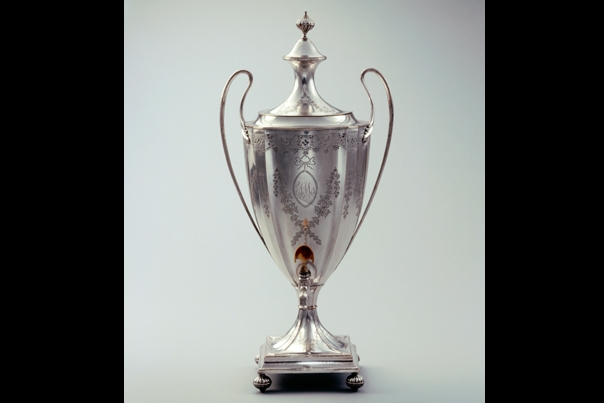
Tea Urn, c. 1785
14 of 21 -
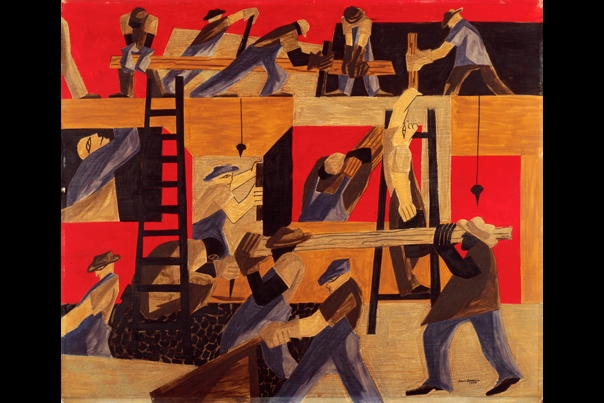
The Builders by Jacob Lawrence, 1947
15 of 21 -
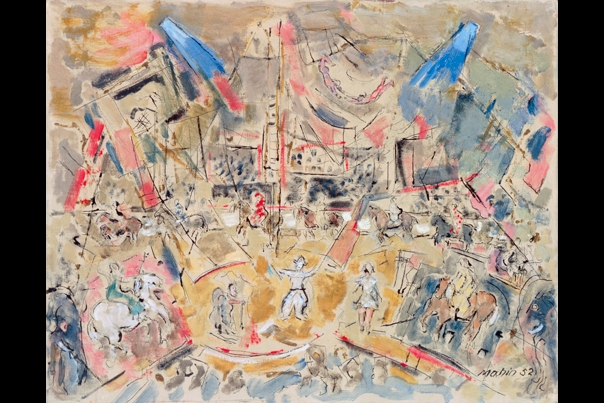
The Circus No. 1 by John Marin, 1952
16 of 21 -

The Mosquito Net by John Singer Sargent, 1912
17 of 21 -
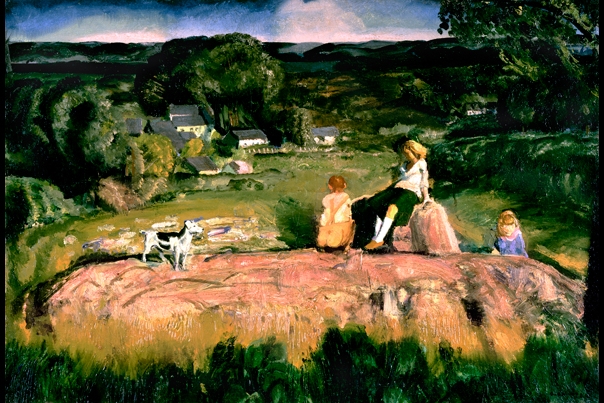
Three Children by George Bellows, 1919
18 of 21 -

Painting of William Henry Harrison by James Reid Lambdin, 1835
19 of 21 -

Work Table attributed to Duncan Phyfe, c. 1810
20 of 21 -
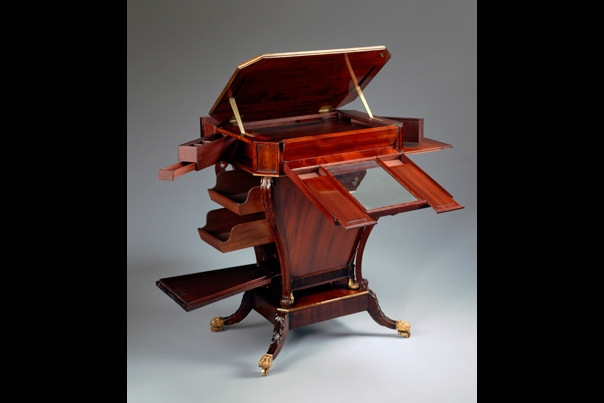
Work Table attributed to Duncan Phyfe, c. 1810
21 of 21
Blue Room
Architect James Hoban’s 1792 plan for the White House included three stacked oval rooms in the center of the building that form a projecting bow on the south side. This room was known by its shape - "Elliptical", "Oval", or "Circular" - until the color was changed to blue in 1837 under Martin Van Buren and a new name emerged.
When it was completely furnished by First Lady Dolley Madison, the Blue Room became the principal formal drawing room of the White House, and the Madisons received their first guests there on New Year's Day, 1810. Among the objects which Dolley Madison had removed to safety in 1814, before evacuating the house to British troops, were the red velvet draperies hanging in this room.
In the refurnishing of the house after the fire of 1814, President and Mrs. James Monroe ordered mahogany furniture for this room, but the purchasing agents in France substituted a 53-piece suite of gilded furniture made in Paris by Pierre-Antoine Bellangé. Although most of this suite was sold at auction in 1860, eight original pieces have been returned to the room since 1961.
Although special meetings, luncheons, and dinners have been held in the room, it continues to be used for the purpose first intended - the formal reception room of the White House. It is here that the President and his wife often receive guests during receptions. The first Chinese delegation to present diplomatic credentials was received by President Rutherford B. Hayes in the Blue Room in 1878. Family events held here include the June 2, 1886 wedding of Grover Cleveland, the only sitting President to marry in the White House. Since 1961 (excepting 1962 and 1969), the principal White House Christmas tree has been placed in the center of the room.
-
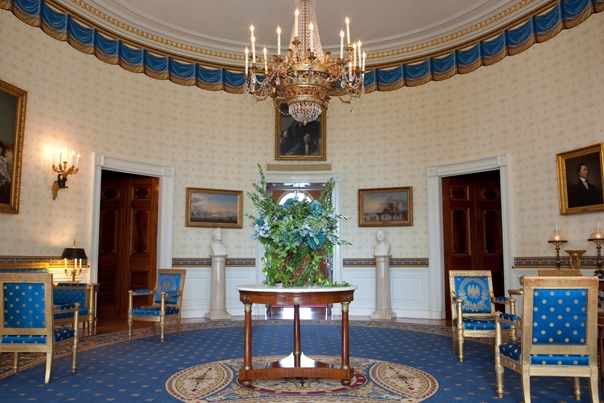
The Blue Room of the White House, Oct. 8, 2009. (Official WH Photo by Samantha Appleton)
1 of 14 -

Amerigo Vespucci, sculpture by Giuseppe Ceracchi, modeled c. 1790-94 & carved c. 1815
2 of 14 -

Bergère by Pierre-Antoine Bellangè, c. 1817
3 of 14 -

Painting by Boston Harbor by Fitz Henry Lane, 1854
4 of 14 -

Boys Crabbing painting by William Tylee Ranney, 1855
5 of 14 -

Christopher Columbus sculpture by Giuseppe Ceracchi, modeled c. 1790-94 & carved c. 1815
6 of 14 -

ting of James Madison by John Vanderlyn, 1816
7 of 14 -

Painting of James Monroe by Samuel Finley Breese Morse, c. 1819
8 of 14 -

Painting of John Adams by John Trumbull, c. 1792
9 of 14 -

Painting of John Quincy Adams by George Peter Alexander Healy, 1858
10 of 14 -

Mantel Clock by Denière et Matelin, c. 1817
11 of 14 -

Painting of Thomas Jefferson by Rembrandt Peale, 1800
12 of 14 -

Pair of Vases, unknown artist, c. 1817
13 of 14 -

Painting of William Howard Taft by Anders Leonard Zorn, 1911
14 of 14
Red Room
The most striking element of this room is its vibrant red color scheme. This parlor has been known as the “Red Room” since 1845, when a suite of furniture upholstered in “Crimson Plush” was introduced to the room.
During Thomas Jefferson’s occupancy of the White House, the Red Room was called the "President's Anti-chamber," a room set aside for those having appointments with the President, whose office was in the adjacent room now used as the State Dining Room. Since then it has been a favorite of President's wives as their "private parlor" to receive friends and official callers.
Inventories of the John Quincy Adams administration note that a pianoforte had been placed in the room. Musical instruments of various descriptions continued to be played here throughout the 19th century, and White House visitors sometimes referred to it as the "Music Room."
Before 19th-century state dinners, the guests would be greeted by the President and his wife in the Red Room. On one such occasion, at a dinner given by out-going President Grant for his successor, Rutherford B. Hayes, guests dined in the State Dining Room unaware that in the Red Room the Chief Justice of the United States had just administered the oath of office to the President-elect while President Grant witnessed the ceremony. Because the 1877 Inauguration Day fell on a Sunday, the oath was administered on Saturday evening with the public ceremonies at the Capital taking place the following Monday.
Theodore Roosevelt used the Red Room as a "smoking room" where male guests adjourned after dinner for cigars and brandy. The room continues to be used today as a parlor for guests after dinner and during receptions.
-

The President in the Red Room prior to a live press conference, March 24, 2009. (Official)
1 of 17 -

Painting of Alexander Hamilton by John Trumbull, c. 1805
2 of 17 -
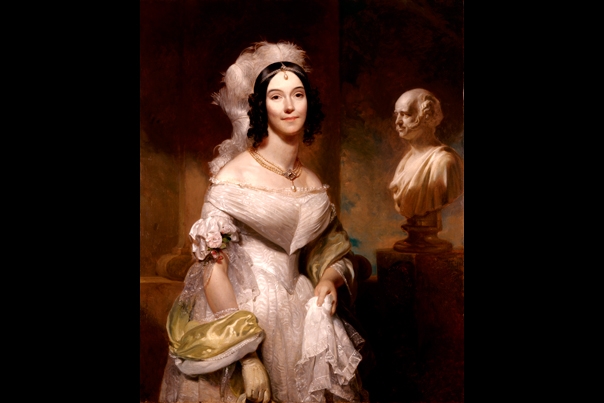
Painting of Angelica Singleton Van Buren (Mrs. Abraham Van Buren) by Henry Inman, 1842
3 of 17 -
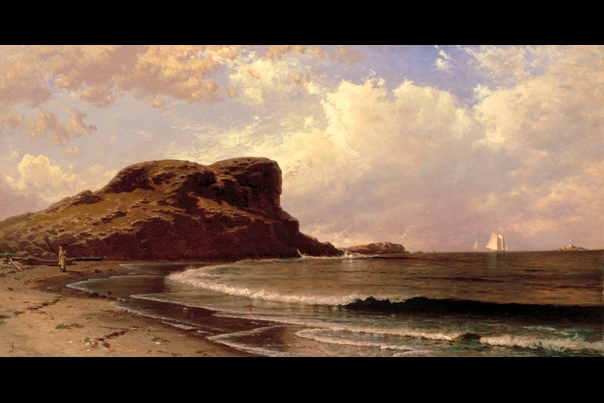
Castle Rock, Nahant, Massachusetts by Alfred Thompson Bricher, 1877
4 of 17 -

Painting of Dolley Payne Madison (Mrs. James Madison) by Gilbert Stuart, 1804
5 of 17 -

Florida Sunrise by Martin Johnson Heade, c. 1890
6 of 17 -

Portrait of Franklin Pierce by George Peter Alexander Healy, 1858
7 of 17 -

Gueridon by Charles-Honoré Lannuier, c. 1810
8 of 17 -

Henry Clay sculpture by Joel Tanner Hart, c. 1850
9 of 17 -

Painting of Martin Van Buren by Francis Alexander, c. 1830
10 of 17 -

Martin Van Buren sculpture by Hiram Powers, modeled 1836 & carved 1840
11 of 17 -
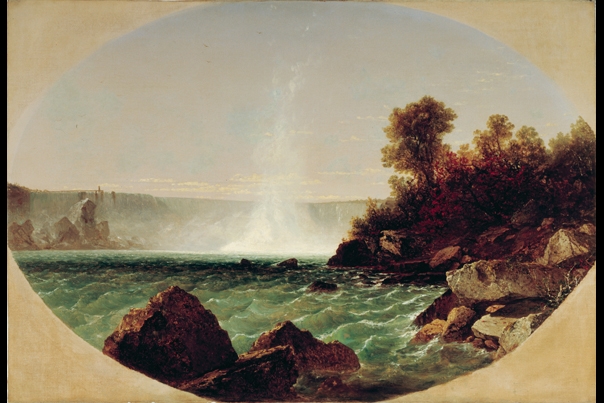
Niagara Falls by John Frederick Kensett, c. 1852
12 of 17 -
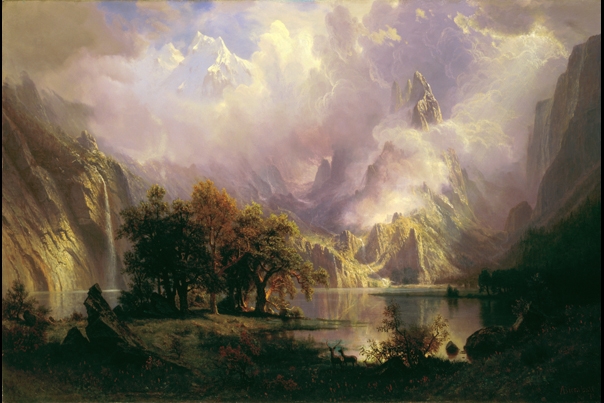
Rocky Mountain Landscape by Albert Bierstadt, 1870
13 of 17 -

Rutherford Birchard Hayes by Daniel Huntington, 1884
14 of 17 -

Sofa, 1810
15 of 17 -

The Indian's Vespers by Asher Brown Durand, 1847
16 of 17 -

Painting of Ulysses Simpson Grant, artist unknown, late 19th century
17 of 17
State Dining Room
This room was Thomas Jefferson’s Cabinet room and office, where he and his secretary, Meriwether Lewis, planned the Lewis and Clark Expedition in 1802. Since 1809, however, it has served as the State Dining Room, with the smaller Family Dining Room to its north. Prior to its enlargement in 1902, 35-40 guests could be seated at a rectangular dining table, 50-65 at an I-shaped table.
In 1902, with the removal of a staircase at this end of the Cross Hall, the State Dining Room was enlarged and completely redesigned for President Theodore Roosevelt. Remaining from that renovation are the oak paneling (first painted in 1952), the three eagle-pedestal side tables, the Queen Anne-style chairs, and the lighting fixtures (gilded in 1961). Wild animal heads that had been hung on the dark wooden walls were removed in the 1920s. Today, using circular tables, as many as 140 guests can dine in the room for formal events.
Ground Floor Corridor
Until 1902, the Ground Floor in the White House served as utilitarian space used by servants. As a result, by the end of the 19th century, James Hoban’s original groin vaulting in the wide corridor of this floor had been cut through in numerous places to accommodate pipes and ducts. The furnace room (now the Diplomatic Reception Room) also jutted into the corridor.
When McKim, Mead, & White created a new guest entrance in the East Wing during the 1902 renovation of the White House, they transformed much of the Ground Floor into public space. All intrusions were removed, the vaulting was restored, and the refurbished corridor received rugs and seating furniture. At First Lady Edith Roosevelt’s initiative, two cabinets were purchased for the corridor in 1904 to display pieces of dinner and dessert services used by former presidents. Mrs. Roosevelt also decided to hang portraits of first ladies in this space, inaugurating a tradition that has been retained to the present.
-

A bust of Abraham Lincoln in the Ground Floor Corridor of the WH (Official- Chuck Kennedy)
1 of 10 -
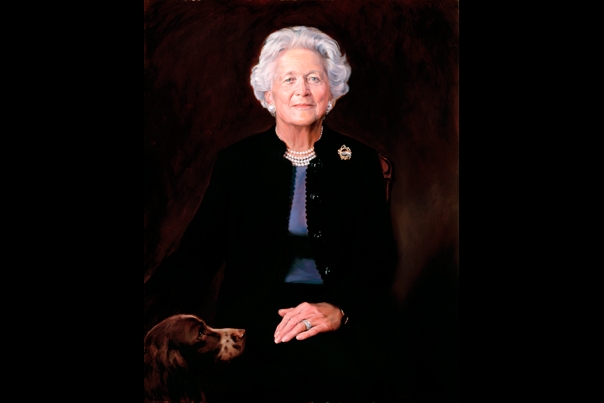
Painting of Barbara Pierce Bush (Mrs. George H. W. Bush) by Charles A. Fagan, 2005
2 of 10 -
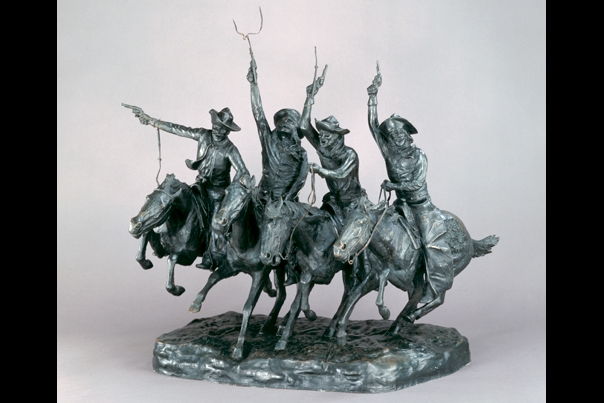
Coming Through the Rye, Sculpture by Frederic Sackrider Remington, modeled 1902, cast 1918
3 of 10 -

Daniel Webster, sculpture by Thomas Ball, 1853
4 of 10 -

Henry Clay, sculpture by Thomas Ball, 1858
5 of 10 -

Painting of Hillary Rodham Clinton (Mrs. William Jefferson Clinton) by Simmie Knox, 2003
6 of 10 -
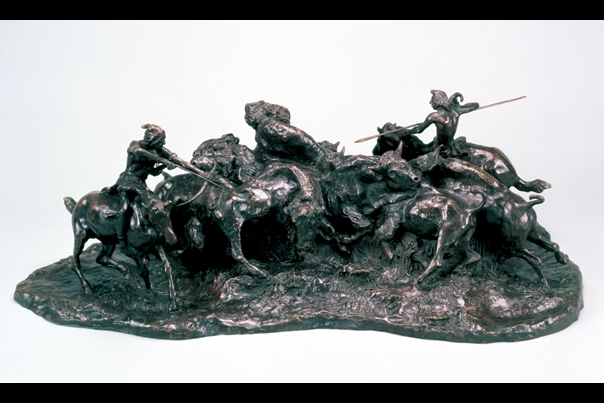
Meat for Wild Men, sculpture by Charles Marion Russell, modeled c. 1920 and cast 1956
7 of 10 -

Pier Table by Duncan Phyfe, 1833
8 of 10 -
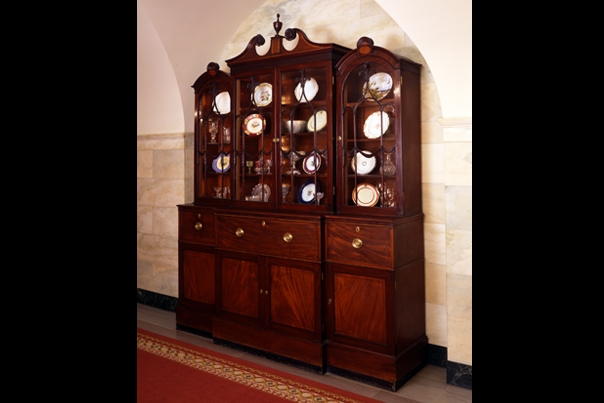
Gift of Mrs. Enid A. Haupt, 1970, c. 1800
9 of 10 -

Side Chair carving attributed to Samuel McIntire, 1794
10 of 10
Library
Most of the Ground Floor rooms were service areas until the Theodore Roosevelt renovation of 1902; this room was generally used as the laundry. Thereafter it became a gentleman’s anteroom and then a library in 1935. Originally compiled in 1961 and updated in 2005, the official White House Library contains 2,700 works of American life and thought. In the modern era, the room has been a favorite for media tapings.
-
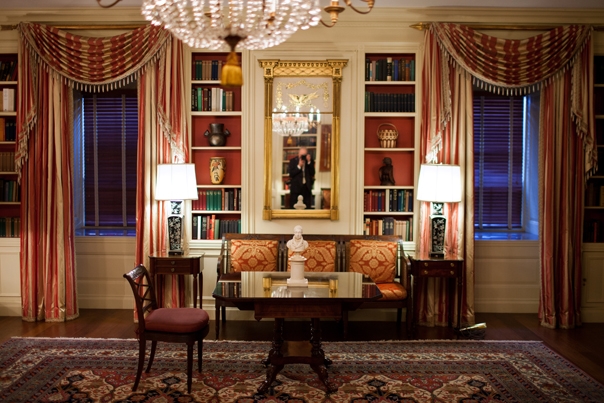
The Library of the White House, January 8, 2010. (Official White House Photo by Chuck Kennedy)
1 of 14 -
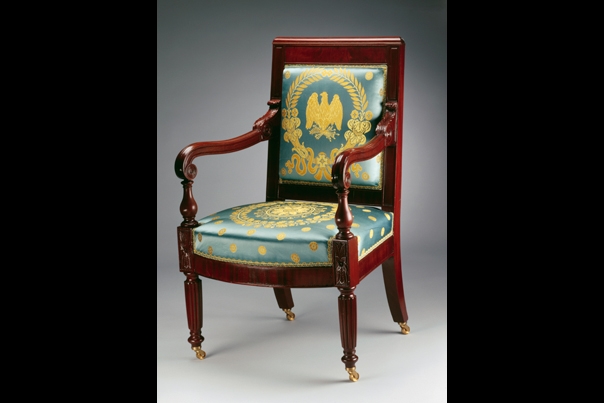
Armchair by William King Jr., 1818
2 of 14 -

Front View of the President's House, in the City of Washington by an unknown artist, 1807
3 of 14 -

Hayne Hudjihini (Eagle of Delight), Oto by Charles Bird King, c. 1822
4 of 14 -

James Hoban sculpture attributed to John Christian Rauschner, c. 1800
5 of 14 -

Marie Joseph Paul Yves Roch Gilbert du Motier, Marquis de Lafayette sculpture, artist unknown, c. 1930
6 of 14 -

Monchousia (White Plume), Kansa painting by Charles Bird King, c. 1822
7 of 14 -

Mountain at Bear Lake - Taos painting by Georgia O'Keeffe, 1930
8 of 14 -

Petalesharro (Generous Chief), Pawnee, painting by Charles Bird King, c. 1822
9 of 14 -

Saber by Klingenthal Armory, c. 1799
10 of 14 -

Saber by Klingenthal Armory, c. 1799
11 of 14 -
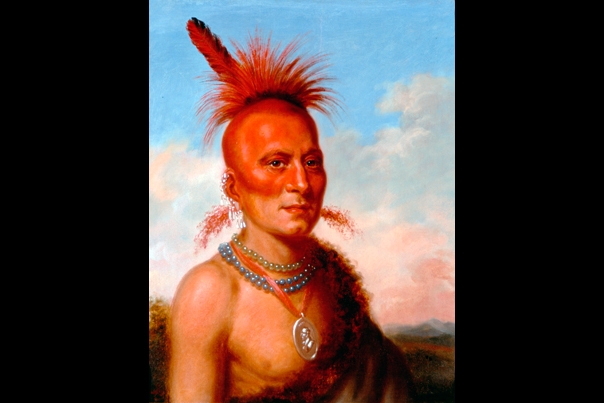
Sharitarish (Wicked Chief), Pawnee, painting by Charles Bird King, c. 1822
12 of 14 -

Shaumonekusse (Prairie Wolf), Oto, painting by Charles Bird King, c. 1822
13 of 14 -
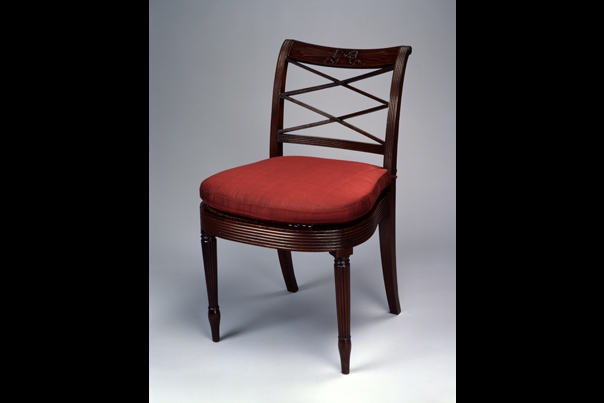
Side chair attributed to Duncan Phyfe, c. 1810
14 of 14
Vermeil Room
The room takes its name from the large collection of vermeil (gilded silver) received by the White House in 1958 as a bequest of Margaret Thompson Biddle, selections of which have been on display in this room ever since. The 1,575 piece collection contains examples of work by the most prominent English and French silversmiths working in the 18th and 19th centuries. Pieces from the vermeil collection are also on display throughout the house.
Until the end of the 19th century, Ground Floor rooms were the domain of White House servants, who probably used this room as a bedroom or storeroom. During a complete renovation of the White House for President Theodore Roosevelt in 1902, this room became a coat/dressing room for female guests. Later, it was used as an office, waiting room, conference room, and billiard room. Since the Nixon administration, it has served as a sitting room.
-

The Vermeil Room of the White House, Jan. 8, 2010. (Official White House Photo by Lawrence Jackson)
1 of 11 -

Painting of Anna Eleanor Roosevelt by Douglas Granville Chandor, 1949
2 of 11 -

Center Table by Anthony Gabriel Quervelle, c. 1829
3 of 11 -

Painting of Jacqueline Bouvier Kennedy Onassis by Aaron Shikler, 1970
4 of 11 -

Painting of Claudia (Lady Bird) Taylor Johnson by Elizabeth Shoumatoff, 1968
5 of 11 -

Painting of Lou Henry Hoover by Richard Marsden Brown,1950
6 of 11 -
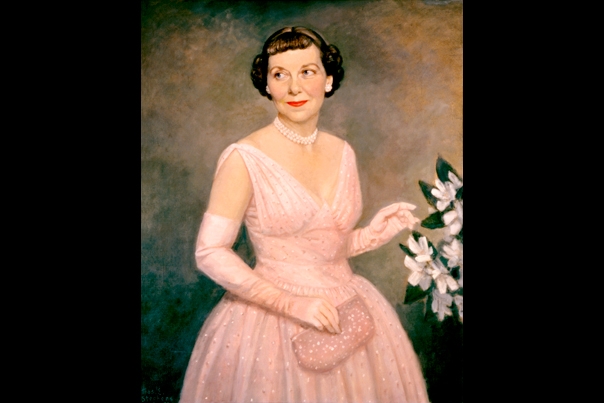
Painting of Mamie Geneva Doud Eisenhower by Thomas Edgar Stephens, 1959
7 of 11 -

Painting of Patricia Ryan Nixon by Henriette Wyeth Hurd, 1978
8 of 11 -

Tureen and Stand by James Young, 1779
9 of 11 -

Water ewer by Richard Sibley, 1817
10 of 11 -

Work Table attributed to Thomas Seymour, c. 1814.
11 of 11
China Room
Since 1917, the Ground Floor room known as the China Room has been used as an exhibition space for examples of ceramics, glass, and silver used in the White House or owned by the first families.
Throughout the 19th century, this room, like the rest of the Ground Floor, had been used by White House servants. It became a public space in 1902, when it was transformed into a coat/dressing room during the Theodore Roosevelt renovation of the White House.
When she became first lady in 1889, Caroline Harrison continued to pursue the Victorian art form of china painting. This hobby and her interest in history (she was the first president of the Daughters of the American Revolution) led her to take an active interest in collecting and preserving White House tableware used in previous administrations. Although she planned to have a cabinet built in the State Dining Room to display examples of White House china services, her idea was not executed before her premature death in 1892, while her husband was running unsuccessfully for re-election.
In 1901, Mrs. McKinley allowed journalist Abby Gunn Baker to survey the surviving White House service pieces which resulted in a scholarly article. In 1904, Mrs. Roosevelt (http://obamawhitehouse.archives.gov/about/first-ladies/edithroosevelt) had two cabinets made for the newly refurbished Ground Floor Corridor to display samples of White House china chosen for this purpose by Ms. Baker, and together they publicized their search for past White House tableware and actively collected examples to supplement what had survived at the White House.
Edith Wilson decided to devote an entire room to display the growing collection of White House china, creating the “Presidential Collection Room” in 1917. Abby Gunn Baker was again asked to select and arrange the china, silver, and glassware installed in built-in cabinets around the room.
-

The China Room of the White House, Jan. 8, 2010. (Official White House Photo by Chuck Kennedy)
1 of 8 -

Grace Goodhue Coolidge (Mrs. Calvin Coolidge) by Howard Chandler Christy, c.1924
2 of 8 -

Grace Goodhue Coolidge (Mrs. Calvin Coolidge) by Howard Chandler Christy, c. 1924
3 of 8 -

Oyster Plate from the Rutherford Hayes State Service by Haviland & Co., 1880
4 of 8 -

Dessert Plate from the James Monroe State Service by Pierre-Louis Dagoty and Edouard Honoré, c. 1817
5 of 8 -

Service Plate from the Ronald Reagan State Service by Lenox, Inc., 1981
6 of 8 -

Service Plate from the Woodrow Wilson State Service by Lenox, Inc., 1918
7 of 8 -

The Farm Landing by Edward Mitchell Bannister, 1892
8 of 8
East Garden Room
This room, at the west end of the East Terrace, is the intersection between the Residence and the East Wing. Double doors in the northwest corner provide entry into the Ground Floor Corridor within the original walls of the White House. The glazed south wall is an extension of the East Colonnade facade, with a door opening into the Jacqueline Kennedy Garden. Coming down the colonnade, guests first see an enormous bronze bust of Abraham Lincoln by Gutzon Borglum in a niche in the west wall, to the right of which hang display panels - historic photographs most of the year, official Christmas cards during the holiday season. Large portraits of four former presidents hang on the other two walls.
-

Members of the public tour the East Garden Room of the White House, April 1, 2009. (Official White House Photo by Samantha Appleton)
1 of 6 -

Abraham Lincoln by John Gutzon De La Mothe Borglum, 1908
2 of 6 -

Calvin Coolidge by Charles Sydney Hopkinson, 1932
3 of 6 -

Chester Alan Arthur by Daniel Huntington, 1885
4 of 6 -
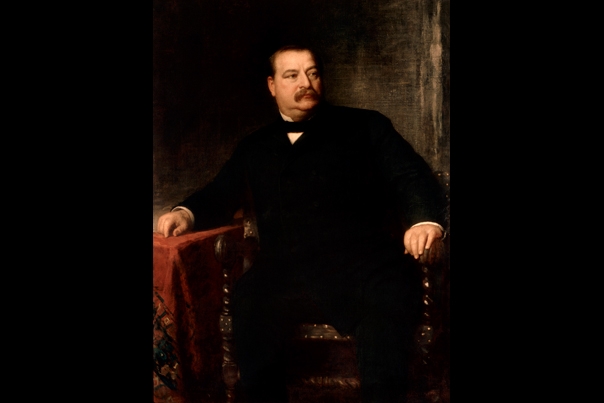
Grover Cleveland by Jonathan Eastman Johnson, 1891
5 of 6 -

Millard Fillmore by George Peter Alexander Healy, 1857
6 of 6


